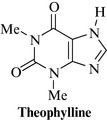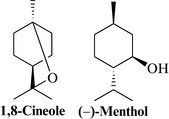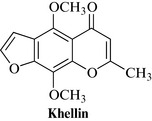Chapter 16 The respiratory system
Bronchodilators and decongestants
Systemic drugs
Ephedra, Ephedra spp. (Ephedrae Herba) 
Constituents
Alkaloids, up to about 3%, but widely varying; the major alkaloid is (–)-ephedrine (Fig. 16.1), together with many others. These include (+)-pseudoephedrine, norephedrine, norpseudoephedrine, ephedroxane, N-methylephedrine, maokonine, transtorine and the ephedradines A–D. Other components are catechin derivatives, and diterpenes, including ephedrannin A and mahuannin A, have been isolated from other species of Ephedra.
Toxicological risks
The herb has been abused as a slimming aid, and an ergogenic aid in sports and athletics, but this is dangerous (Fleming 2008). For example, hypertension and other cardiovascular events, and a case of exacerbation of hepatitis, have been noted with high doses. The absorption of ephedrine and pseudoephedrine is slower after ingestion of the herb than for isolated alkaloid preparations, and the other constituents, the ephedradins, mahuannins and maokonine, are mildly hypotensive; but both the herb and the isolated alkaloids should be avoided by hypertensive patients as well as in cases of thyrotoxicosis, narrow-angle glaucoma and urinary retention. Therapeutic doses of the herb are calculated to deliver up to 30 mg of the alkaloids, calculated as ephedrine.
Theophylline 
Although a natural xanthine, theophylline (Fig. 16.2), which is found in cocoa (Theobroma cacao), coffee (Coffea spp.) and tea (Camellia sinensis), is almost invariably used as the isolated compound. It is indicated in reversible airways obstruction, particularly in acute asthma. Because of the narrow margin between the therapeutic and the toxic dose, and the fact that the half-life is highly variable between patients, especially smokers and in heart failure or with concurrent administration of other drugs, care must be taken. The usual dose is 125–250 mg in adults, three times daily, and half of that in children.
Inhalations
Camphor 
Camphor (Fig. 16.3), a pure natural product, is derived from the Asian camphor tree (Cinnamomum camphora T. Nees & Eberm., Lauraceae). It is often combined with the essential oil containing drugs as an aromatic stimulant and decongestant.
Eucalyptus oil, Eucalyptus spp. (Eucalypti aetheroleum) 
Constituents
The oil contains 1,8-cineole (eucalyptol; see Fig. 16.4) as the major component, with terpineol, α-pinene, p-cymene and small amounts of ledol, aromadendrene and viridoflorol, aldehydes, ketones and alcohols.
Menthol 
Menthol is a monoterpene (Fig. 16.4) extracted from mint oils, Mentha spp. (especially M. arvensis) or it can be made synthetically. Whole peppermint oil is used in herbal combinations to treat colds and influenza (as well as for colic, etc.; see Chapter 14), but isolated menthol is an effective decongestant used in nasal sprays and inhalers. Menthol can be irritant and toxic in overdose, but is generally well tolerated in normal usage.
Anti-allergics
Butterbur, Petasites hybridus L.
Therapeutic uses and available evidence
Butterbur is traditionally used as a remedy for asthma, colds, headaches and urinary tract disorders. It is used as an antihistamine for seasonal allergic rhinitis, and a recent randomized, double-blind comparative study using 125 patients over 2 weeks of treatment showed that butterbur extract is as potent as cetirizine. The anti-inflammatory activity is due mainly to the petasin content. Extracts inhibit leukotriene synthesis and are spasmolytic, and reduce allergic airway inflammation and AHR by inhibiting the production of the Th2 cytokines IL-4 and IL-5, and RANTES (Brattström et al 2010), thus supporting its use in asthma. Use as prophylactic treatment for migraine has also been suggested but further evidence of efficacy is needed (Agosti et al 2006). The usual dose is an extract equivalent to 5–7 g of herb or root. Internal use is not recommended unless the alkaloids are present in negligible amounts or have been removed from preparations, as is the case with the commercially available product, which is a ‘special extract’. Maximum intake of the alkaloids should be less than 1 μg daily for fewer than 6 weeks per year.











